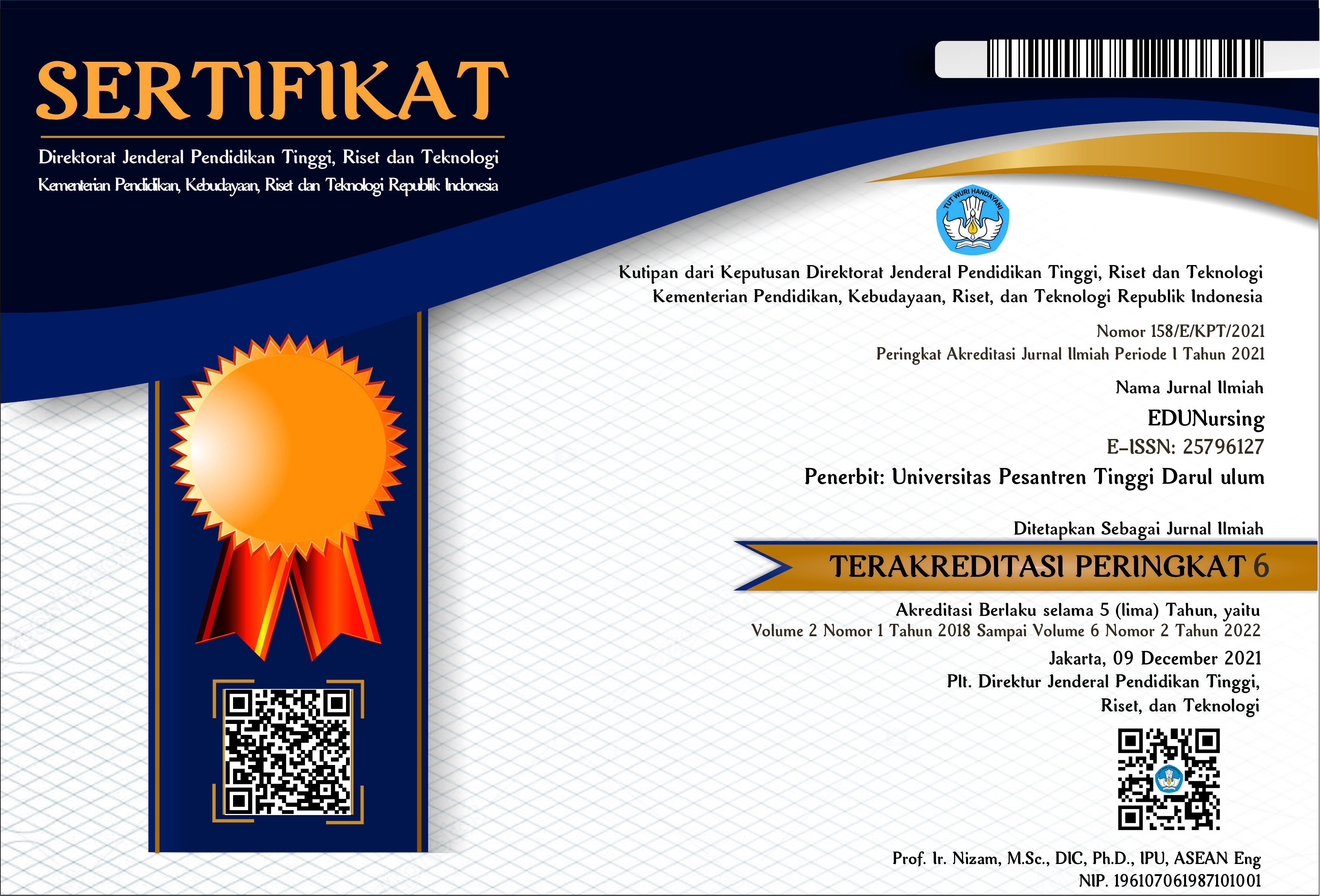HUBUNGAN UMUR IBU DAN PARITAS DENGAN DERAJAT LASERASI PERINEUM DI RSUD DR. R GOETENG TAROENADIBRATA PURBALINGGA
Abstract
ABSTRACT
Perineal laceration or also known as perineal rupture is one of the most often trauma suffered by women during childbirth, even during normal delivery child birth process. Laceration can be classified as mild (first and second degrees) and severe (third and fourth degrees). Perineal laceration may occur due to several factors such as age of mother and parity. Large infant head and rigid perineal muscles in primiparous can cause perineal laceration due to the perineum is not strong enough to hold the babies head strain.
This research aims to determine the relationship between age of mother and parity with perineal laceration degree at dr R. Goeteng Taroenadibrata Hospital, Purbalingga.
The research design uses corelation study with retrospective approach. Samples were collected using quota sampling technique. Respondents in this research were 305 mothers who gave birth spontaneously with perineal lacerations. Data was taken by performing documentation study using ssecondary data.
There results of corellation between age of mother and perineal laceration degree with p-value 0,136 > ? 0,05 and corellation between parity with perineal laceration degree with p-value 0,000 < ? 0,05. The conclusions of this research are there was corellation between age of mother with perineal laceration degree and there was a significant relationship between parity with perineal laceration degree.
Keywords: age of mother, parity, perineal laceration degree.
References
DAFTAR PUSTAKA
Aasheim, V. Et al. (2017) Perineal Techniques During The Second Stage of Labour for Reducing Perineal Trauma (Review). [http] Cochrane Library. Available from: http://cochranelibrary-wiley.com/doi/10.1002/14651858.CD006672.pub3/pdf/abstract [Accessed 20/ 3/ 18]
Abdullah, S dan Sutanto, T.E. (2015) Satatistika Tanpa Stress. Jakarta Selatan: Transmedia Pustaka.
Aigmueller, T. Et al. (2015) Management of 3rd and 4th Degree Perineal Tears after Vaginal Birth. German Guideline of the German Society of Gynecology and Obstetrics (AWMF Registry No. 015/079, October 2014) [www] Geburtshilfe Frauenheilkd. Available from: https://www.ncbi.nlm.nih.gov/pmc/articles/PMC4477621/ [Accessed 2/ 2/ 18].
Anggraini, F.D. (2016) Hubungan berat bayi dengan robekan perineum pada persalinan fisiologis di RB Lilik Sidoarjo. Jurnal Ilmiah Kesehatan, 9 (1), pp. 91-97.
Aprillia, Y. (2010) Hipnostetri: Rileks, Nyaman dan Aman Saat Hamil & Melahirkan. Jakarta: GagasMedia.
BKKBN (2008)
Bornemeier, W.C. (2015) Obstetric Anal Sphincter Injury (OASI): Third or Fourth Degree Perineal Tear. Sydney Pelvic Floor Health. Available from: sydney.edu.au [Accessed 18/ 4/ 2018].
Damayanti, I.P. et al. (2014) Buku Ajar: Asuhan Kebidanan Komprehensif Pada Ibu Bersalin dan Bayi Baru Lahir. Yogyakarta: Deepublish.
Detiana, P. (2010) Hamil Aman dan Nyaman Diatas Usia 30 Tahun. Yogyakarta: Media Pressindo.
Doni, S.D. (2017) Hubungan berat badan lahir dengan derajat ruptur perineum pada persalinan normal. Jurnal Keperawatan Intan Husada, 4 (1), pp. 30-38.
Edozien, LC. et al. (2014) Impact of third‐ and fourth‐degree perineal tears at first birth on subsequent pregnancy outcomes: a cohort study [www] An International Journal of Obstetrics & Gynaecology (BJOG). Available from: https://www.ncbi.nlm.nih.gov/pubmed/25040835 [Accessed 26/ 10/ 17]
Frigerio, M. et al. (2016) Third and Fourth Degree Perineal Tears: Incidence and Risk Factors in an Italian Setting. European Journal of Obstetrics & Gynecology and Reproductive Biology, (206), pp e27.
Garedja, YY. et al. (2013) Hubungan Berat Badan Lahir Dengan Ruptur Perineum Pada Primipara di RSUP Prof. Dr. R. D. Kandou Manado. Jurnal e-Biomedik (eBM), 1 (1), pp. 719-725.
Hidayat, A. (2011). Metode Penelitian Keperawatan Dan Teknik Analisa Data. Jakarta: Salemba Medika.
Klein, S et al. (2012) Buku Bidan: Asuhan Pada Kehamilan, Kelahiran & Kesehatan Wanita. Jakarta: EGC.
Kristianti, S dan Putriyana, Y. (2015) Hubungan Senam Kegel Pada Ibu Hamil Primigravida TM III Terhadap Derajat Robekan Perineum di Wilayah Puskesmas Pembantu Bandar Kidul Kota Kediri. Jurnal Ilmu Kesehatan, (ISSN 2303-1433), 3 (2), pp. 91-98.
Lapau, B. (2013) Metode Penelitian Kesehatan: Metode Ilmiah Penulisan Skripsi, Tesis dan Disertasi. Jakarta: Yayasan Pustaka Obor Indonesia anggota IKAPI DKI Jakarta.
Lusiana, N. et al. (2015). Buku Ajar Metodologi Penelitian Kebidanan. Yogyakarta: Deepublish.
Manuaba, I.A.C. et al. (2009) Memahami Kesehatan Reproduksi Wanita. Edisi ke-2. Jakarta: EGC.
Manuaba, I.B.G. et al. (2012) Pengantar Kuliah Obstetri. Jakarta: EGC.
Marmi. (2012) Intranatal Care: Asuhan Kebidanan Pada Persalinan. Yogyakarta: Pustaka Pelajar.
Nasution, N. (2011) Faktor-faktor yang Berhubungan dengan Terjadinya Ruptur Perineum pada Ibu Bersalin Di RSU Dr.Pirngadi Medan Periode Januari-Desember 2007. Dalam: Prawitasari, Eka, dkk. (2015) Penyebab Terjadinya Ruptur Perineum pada Persalinan Normal di RSUD Muntilan Kabupaten Magelang. Jurnal Ners dan Kebidanan Indonesia, (ISSN2354-7642), pp. 77-81.
Nurjanah, N. (2015) Hubungan antara paritas ibu bersalin dan berat badan bayi baru lahir dengan kejadian ruptur perineum pada persalinan normal di RSUD Indramayu periode Januari – Juni tahun 2015, (10), pp. 221-232
Nursaidah. (2017) Pengaruh Berat Badan Lahir Bayi, Umur, Paritas Terhadap Ruptura Perineum Pada Ibu Bersalin di RSUD Sidoarjo. Hospital Majapahit, 9 (2), pp. 66-77.
Oxorn, H dan Forte, W.R. (2010) Ilmu Kebidanan: Patologi dan Fisiologi Persalinan. Yogyakarta: CV. Andi Offset dan Yayasan Essentia Medika.
Pinder, L.F. et al. (2017) Nurse-midwives’ ability to diagnose acute third- and fourth-degree obstetric lacerations in western Kenya. BMC Pregnancy and Childbirth, 17 (308) pp. 1-5.
Praptomo, Agus Joko. Et al. (2016). Metodologi Riset Kesehatan Teknologi Laboratorium Medik dan Bidang Lainnya. Yogyakarta: Deepublish.
Proverawati. (2010). Senam Kesehatan Aplikasi Senam Untuk Kesehatan. Yogyakarta: Muha Medika.
Sani K, F. (2016) Metodologi Penelitian Farmasi Komunitas dan Eksperimental. Yogyakarta: Deepublish.
Santos, R.C.S.D dan Riesco, M.L.G. (2016) Implementation of care practices to prevent and repair perineal trauma in childbirth. Revista Gaúcha de Enfermagem (RGE), 37(spe):e68304, pp. 1-11.
Scott, J. (2017). Prevention of Obstetric Lacetation. University of Colorado Hospital, pp. 1-26. Available from: http://www.cuvailobgyn.com/uploads/2/3/6/9/23693993/2._vail2017_prevention_of_ob_lacs_scott.pdf [Accessed 20/ 3/18].
Setiadi. (2013). Konsep dan Praktek Penulisan Riset Keperawatan. Edisi ke-2. Yogyakarta: Graha Ilmu.
Sinclair, C. (2009) Buku Saku Kebidanan. Edisi bahasa Indonesia. Jakarta: EGC
Smith, LA. et al. (2013) Incidence of and risk factors for perineal trauma: a prospective observational study. BMC Pregnancy and Childbirth, 13 (59), pp. 1-9.
Sondakh, J.J.S. (2013) Asuhan Kebidanan Persalinan & Bayi Baru Lahir. Jakarta: Penerbit Erlangga.
Suryani dan Hendryadi. (2015) Metode Riset Kuantitatif: Teori dan Aplikasi Pada Penelitian Bidang Manajemen dan Ekonomi Islam. Jakarta: Prenadamedia Group.
Sumantri, A. (2011) Metodologi Penelitian Kesehatan. Edisi Pertama. Jakarta: Kencana prenada Media Group.
Swarjana, I.K. (2012) Metodologi Penelitian Kesehatan. Yogyakarta: CV Andi Offset.
Wasis. (2008) Pedoman Riset Praktis Untuk Profesi Perawat. Jakarta: EGC
WHO. (2008) World Health Organization. Education material for teachers of midwifery : midwifery education modules. 2nd ed. [http] World Health Organization. Available from: http://apps.who.int/iris/bitstream/10665/44145/5/9789241546669_5_eng.pdf [Accessed 26 Oktober 2017].
Wiknjosastro, H. (2006) Ilmu Kebidanan. Dalam: Doni, Stefania Dai. (2017) Hubungan berat badan lahir dengan derajat ruptur perineum pada persalinan normal. Jurnal Keperawatan Intan Husada, 4 (1), pp. 30-38.
Yeni, R.M. (2014) Robekan Perineum.[https] Wordpress. Tersedia dari: https://rizkimarizayeni.wordpress.com/2014/06/24/robekan-perineum/ [Diakses 9 November 2017].
Zulfikar dan Budiantara, I.N. (2014) Manajemen Riset Dengan Pendekatan Komputasi Statistika. Yogyakarta: Deepublish.
Downloads
Published
Issue
Section
License






